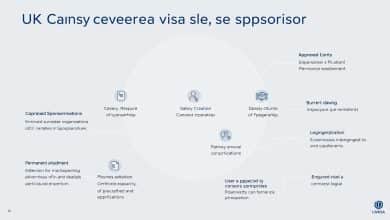Australia Visa Sponsorship Explained: TSS 482 vs ENS 186 — Eligibility, Skills Lists & PR Pathways
Skilled labor shortages continue to challenge many industries.
Healthcare, technology, and construction face particular difficulties finding qualified workers. This situation creates significant opportunities for international professionals.
Employer sponsorship is a government-regulated program. It allows businesses to hire overseas talent for specific roles they cannot fill locally. This process offers both temporary and permanent residency options.
This guide explores the two primary skilled migration pathways. It details the Temporary Skill Shortage (TSS) 482 and the Employer Nomination Scheme (ENS) 186. Readers will learn the key differences and eligibility requirements for each.
The article provides clear information on occupation lists and skills assessments. It also explains how temporary workers can transition to permanent status. This knowledge helps both employers and employees make informed decisions.
Introduction to Australia Visa Sponsorship
Persistent gaps in the domestic labor market make skilled migration a vital component for industry growth. This process is formalized through employer sponsorship, a program where a local business can hire an overseas worker for a role it cannot fill locally.
Overview of Employer Sponsorship in Australia
The business becomes the official sponsor, and the worker is the nominee. This is a legally binding arrangement, not just a simple hire. It carries ongoing responsibilities for the employer.
These duties extend before, during, and after the employment period. The government regulates the entire process to ensure compliance and protect all parties involved.
Why Skilled Migration is Essential in 2025
In 2025, a significant shortage of skilled workers continues to challenge key sectors. Hospitality, healthcare, construction, and IT are particularly affected. Regional services also struggle to find qualified staff.
The government’s Migration Strategy, updated in late 2023, reinforces this pathway. It positions employer-sponsored immigration as a primary solution for genuine economic needs. This approach offers a clear route to permanent residency for talented individuals.
For businesses, it provides access to a global pool of talent. For skilled workers, it creates legitimate opportunities for employment and long-term settlement.
Understanding the TSS 482 Visa and Its Requirements
The most frequently used employer-sponsored option is designed for skilled roles. This program allows a business to bring in an overseas professional for up to four years.
It addresses specific gaps that cannot be filled by the local workforce. The process involves several key steps and strict criteria.
Eligibility Criteria for the 482 Visa
Applicants must meet several conditions for the subclass 482. They need relevant qualifications and work experience in their chosen field.
English language proficiency is a fundamental requirement. This is typically proven through approved testing methods.
Health and character standards must also be satisfied. A positive skills assessment may be necessary for certain occupations.
Labour Market Testing and Position Nomination
Before a nomination, the employer must show no local worker was available. This involves advertising the role on national platforms for at least 28 days.
The nominated position must be genuine and full-time. Its salary must meet or exceed the official income threshold.
The role must also be on an approved skilled occupation list. This ensures the program targets genuine skill shortages.
Exploring the Employer Nomination Scheme (ENS) 186 Visa
For professionals seeking long-term settlement opportunities, the Employer Nomination Scheme represents a significant milestone. This program grants immediate permanent residency status upon approval.
The subclass 186 offers two distinct streams for different applicant backgrounds. Both lead to the same permanent outcome but follow different routes.
Direct Entry vs. Temporary Residence Transition Paths
The Direct Entry stream suits applicants from overseas or other visa categories. It requires the occupation to be on the MLTSSL list.
Applicants need relevant qualifications and at least three years of work experience. They must also meet English language requirements.
The Temporary Residence Transition pathway is for current 482 holders. These workers have already demonstrated their value to the employer.
This stream typically requires three years of employment with the same sponsor. It offers more lenient requirements due to proven work history.
Pathways to Permanent Residency
The transition from temporary to permanent status requires careful planning. Workers must maintain continuous employment with their sponsoring employer.
This pathway ensures compliance with all conditions throughout the process. Successful applicants gain unrestricted work rights and access to healthcare.
Both streams provide a clear route to long-term settlement. The choice depends on individual circumstances and employment history.
Comparing TSS 482 and ENS 186 Visa Options
The decision between temporary and permanent employer-sponsored programs involves significant considerations for both businesses and skilled professionals. Each pathway serves distinct purposes with different timelines and outcomes.
Key Differences in Skills Lists and Eligibility
The subclass 482 offers more flexibility with occupation lists. Workers can qualify for roles on both the MLTSSL and STSOL. This provides broader options for temporary employment.
The subclass 186 requires occupations exclusively from the MLTSSL for Direct Entry. Eligibility criteria also differ significantly between the two programs. Age limits and experience requirements are typically stricter for permanent pathways.
Nomination Processes and Compliance Obligations
Labour Market Testing is a key differentiator in the nomination process. Most 482 applications require demonstrating unsuccessful local recruitment efforts. This step is often waived for the Temporary Residence Transition stream of the 186 program.
Both programs demand Standard Business Sponsor approval and market salary compliance. However, permanent sponsorship carries longer-term employer responsibilities. The financial commitment extends beyond the initial employment period.
Understanding these distinctions helps stakeholders choose the most appropriate pathway. Temporary options suit testing employment relationships, while permanent solutions offer stability.
Navigating the Sponsorship Process for Skilled Workers
The journey toward employer sponsorship follows a clear, three-stage process that requires careful preparation. Each step builds upon the previous one, creating a structured pathway for both businesses and applicants.
Step-by-Step Guide to Sponsorship Approval
Stage one involves Standard Business Sponsor approval. Companies must demonstrate legitimate operations through business registration, financial records, and payroll documentation.
This initial application typically processes within 4-8 weeks. Successful approval grants five-year sponsorship rights.
Stage two requires position nomination. Employers must confirm the role appears on skilled occupation lists and meets salary thresholds.
Labour Market Testing demands advertising on national platforms for 28 days. Evidence must show no suitable local candidates applied.
Essential Documentation and Legal Requirements
The final step involves the worker’s application. This requires skills assessments, language test results, and health examinations.
Police clearances from all countries of residence are mandatory. Complete documentation prevents processing delays.
Many cases allow concurrent lodgement of nomination and application. This strategy can significantly reduce overall processing time.
Professional guidance often proves valuable for complex situations. Proper preparation ensures smoother navigation through each requirement.
Australia visa sponsorship for Skilled Workers
The strategic benefits of skilled migration extend well beyond immediate staffing solutions. This pathway offers a sustainable model for workforce development.
For employers, this program provides access to a global talent pool. They can find individuals with specialized expertise not readily available locally. This investment builds a more resilient and innovative business.
Benefits for Employers and Overseas Applicants
Companies gain team members who are highly committed. The pathway to permanent residency encourages long-term retention. This reduces turnover and builds a stable workforce.
Sponsorship isn’t just about filling a vacancy—it’s about investing in the future of the business.
For overseas workers, this migration route offers security. They receive employer support throughout the application process. Their employment is arranged before they move, reducing risk.
Sustainability and Long-Term Workforce Advantages
The long-term advantages are clear for both parties. Businesses can plan for the future with confidence. Skilled workers secure a legitimate path to settling in the country.
Consider a regional aged care facility’s success. After struggling to hire locally, they sponsored three nurses. Within 18 months, these workers transitioned to permanent roles.
- Access to international experience and perspectives
- Higher retention rates and employee loyalty
- Solution for chronic skill gaps in key sectors
This approach transforms workforce planning. It allows employers to invest in training knowing workers will stay for years. It establishes companies as employers of choice.
Strategies for Finding an Employer Sponsor in Australia
Finding a willing sponsor demands targeted efforts and professional networking. Successful applicants often combine multiple approaches to increase their chances.
Before starting the search, candidates should understand program requirements. This knowledge helps them present as informed, attractive prospects.
Utilizing Online Job Portals and Professional Networks
Job seekers should focus on platforms like Seek with specific search terms. Keywords like “employer sponsored” or “482” filter relevant opportunities.
Professional networking creates valuable connections. Attend industry events and engage on LinkedIn to meet potential sponsors.
Building relationships often leads to sponsorship opportunities. This approach works well for both onshore and offshore applicants.
Targeting Approved and Accredited Sponsors
Researching already-approved sponsors saves significant time. These employers understand the process and requirements.
Public registers list Standard Business Sponsors and accredited companies. Targeting these organizations increases success rates.
- Focus on employers with sponsorship experience
- Prepare comprehensive application materials
- Highlight relevant skills and qualifications
Regional areas often offer more opportunities due to skill shortages. Consider locations outside major cities for better prospects.
Important advice: Never pay for sponsorship arrangements. This illegal practice carries severe penalties for both parties.
Conclusion
Successful migration outcomes depend on understanding the distinct advantages of each sponsorship option. This guide has detailed the primary pathways available to skilled professionals seeking opportunities.
The TSS subclass 482 offers temporary employment for up to four years. The ENS subclass 186 provides immediate permanent residency for qualified applicants. Both programs address genuine skill shortages in key sectors.
Thorough preparation is essential for navigating the application process. Understanding occupation lists, skills assessment requirements, and compliance obligations increases success rates. Proper documentation saves valuable time.
For employers, this pathway represents a strategic investment in workforce development. Accessing international talent builds stable, skilled teams. The long-term benefits outweigh the initial responsibilities.
Skilled workers should approach their search strategically. Professional guidance from migration services can clarify complex requirements. With careful planning, both parties achieve their goals through this structured pathway.
For more information, explore the official visa website mentioned in this article:
You will be redirected to another website
FAQ
What is the main difference between the TSS 482 and ENS 186 visas?
The primary distinction lies in their purpose. The TSS 482 is a temporary visa allowing skilled individuals to work for a specific employer for up to four years. The ENS 186 is a permanent residency visa, offering a long-term pathway to live and work in the country.
How can an overseas worker qualify for the Employer Nomination Scheme?
Eligibility typically requires a positive skills assessment, at least three years of relevant work experience, and meeting age, English language, and health standards. The sponsoring business must also nominate the position and demonstrate a genuine need.
What is Labour Market Testing and when is it required?
Labour Market Testing is a process where an employer must show they have tested the local job market and could not find a suitable Australian worker for the position. It is a standard requirement for most Temporary Skill Shortage visa nominations.
Can a TSS 482 visa holder transition to permanent residency?
Yes, a common pathway is through the Temporary Residence Transition stream of the ENS 186 visa. This typically requires the applicant to have worked for their sponsor for at least two to three years on their TSS visa before applying.
What are the key obligations for a business that becomes a sponsor?
Approved sponsors have several legal duties. These include paying the overseas worker a market salary rate, adhering to all local workplace laws, and cooperating with immigration authorities. They must also ensure the worker only performs the nominated occupation.
Where can skilled migrants find employers willing to sponsor them?
Job seekers should target online portals that list sponsorship opportunities and leverage professional networks. Focusing on companies that are already approved sponsors can significantly streamline the application process.
Published on: 17 de October de 2025

Abiade Martin
Abiade Martin, author of WallStreetBusiness.blog, is a mathematics graduate with a specialization in financial markets. Known for his love of pets and his passion for sharing knowledge, Abiade created the site to provide valuable insights into the complexities of the financial world. His approachable style and dedication to helping others make informed financial decisions make his work accessible to all, whether they're new to finance or seasoned investors.






